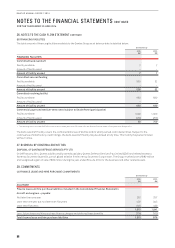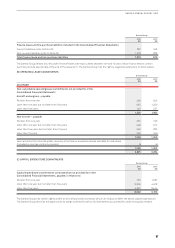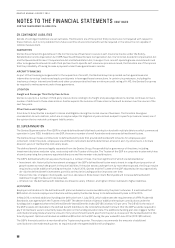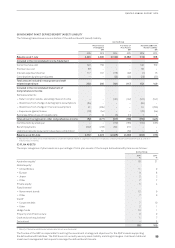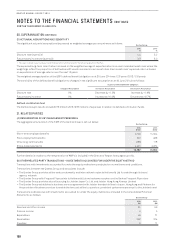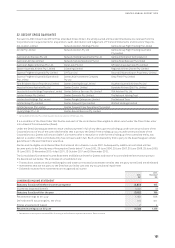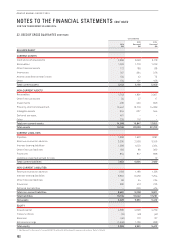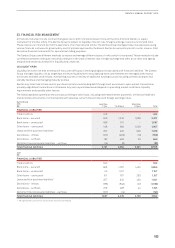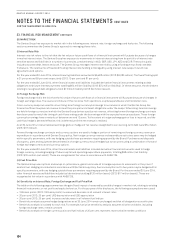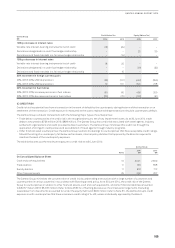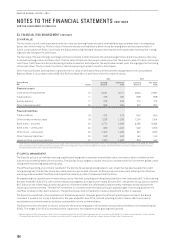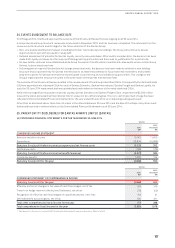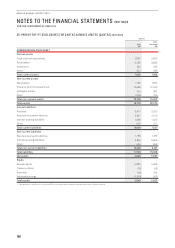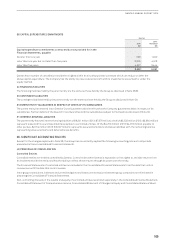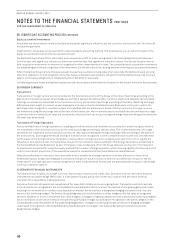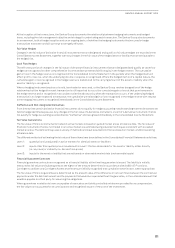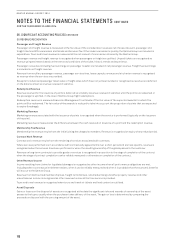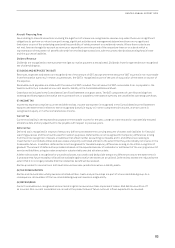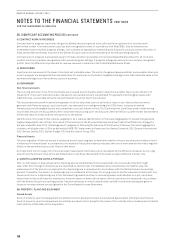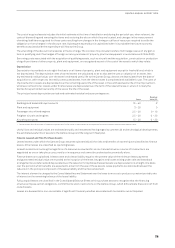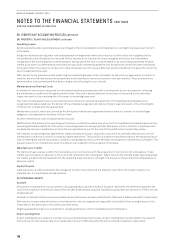Qantas 2014 Annual Report Download - page 108
Download and view the complete annual report
Please find page 108 of the 2014 Qantas annual report below. You can navigate through the pages in the report by either clicking on the pages listed below, or by using the keyword search tool below to find specific information within the annual report.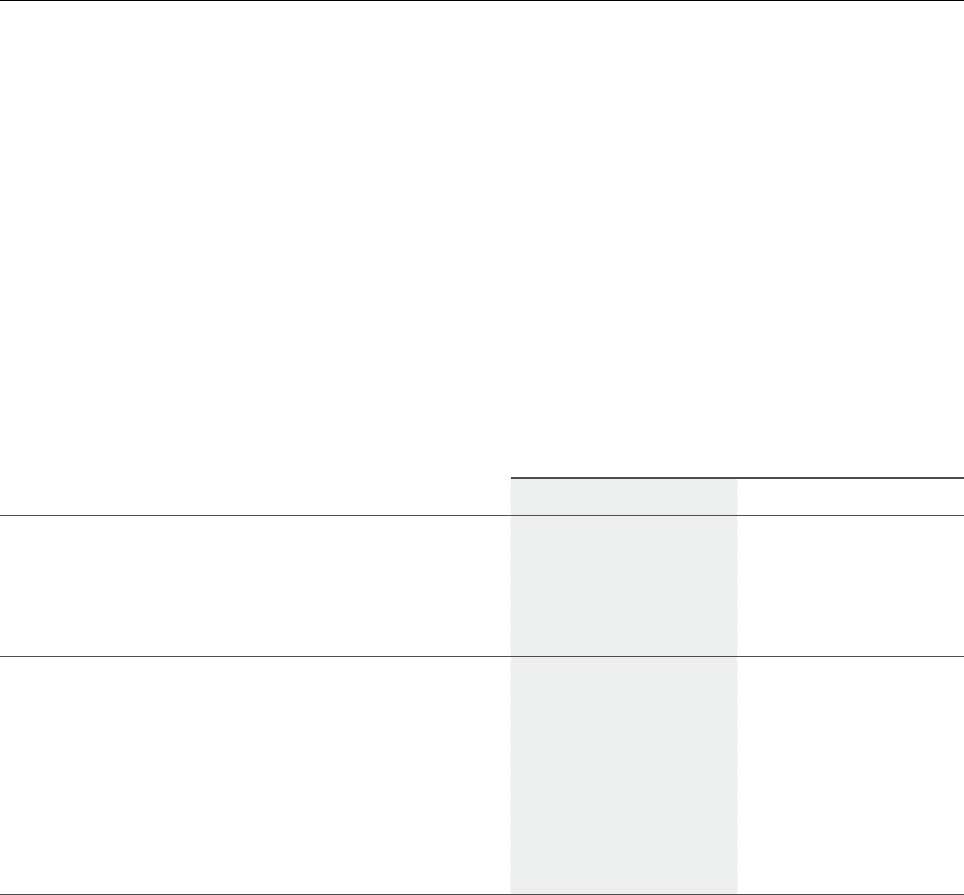
106
QANTAS ANNUAL REPORT 2014
NOTES TO THE FINANCIAL STATEMENTS CONTINUED
FOR THE YEAR ENDED 30 JUNE 2014
33. FINANCIAL RISK MANAGEMENT CONTINUED
(D) FAIR VALUE
The fair value of cash, cash equivalents and non-interest-bearing financial assets and liabilities approximates their carrying value
due to their short maturity. The fair value of financial assets and liabilities is determined by valuing them at the present value of
future contracted cash flows. Cash flows are discounted using standard valuation techniques at the applicable market yield, having
regard to the timing of the cash flows.
The fair value of forward foreign exchange and fuel contracts is determined as the unrealised gain/loss at balance date by reference
to market exchange rates and fuel prices. The fair value of interest rate swaps is determined as the present value of future contracted
cash flows. Cash flows are discounted using standard valuation techniques at the applicable market yield, having regard to the timing
of the cash flows. The fair value of options is determined using standard valuation techniques.
Other financial assets and liabilities represent the fair value of derivative financial instruments recognised on the Consolidated
Balance Sheet in accordance with AASB 139. Refer to Note 36 for a definition of the fair value hierarchy.
Qantas Group
$M Notes
2014 2013
Carrying
Amount
Fair Value
Total
Carrying
Amount
Fair Value
Total
Financial assets
Cash and cash equivalents 10 3,001 3,011 2,829 2,837
Trade debtors 11 736 736 898 898
Sundry debtors 11 618 618 712 712
Other financial assets125 206 206 207 207
Financial liabilities
Trade creditors 18 613 613 640 640
Other creditors and accruals 18 1,238 1,238 1,204 1,204
Bank loans – secured 20 2,772 2,608 3,285 3,393
Bank loans – unsecured 20 996 1,022 992 1,056
Other loans – unsecured 20 1,405 1,469 927 1,065
Other financial liabilities125 248 248 140 140
Lease and hire purchase liabilities 20 1,310 1,293 876 942
1 Other financial assets and liabilities represent the fair value of derivative financial instruments recognised on the Consolidated Balance Sheet in accordance with AASB 139. These
derivative financial instruments have been measured at fair value using Level 2 inputs in estimating their fair values. The different methods of estimating the fair value of financial
instruments measured at fair value are defined in Note 36.
(F) CAPITAL MANAGEMENT
The Board’s policy is to maintain a strong capital base designed to maximise shareholder value, maintain creditor confidence and
sustain future development of the business. The Qantas Group targets a capital structure consistent with an investment grade credit
rating while maintaining adequate liquidity.
The difficult operating environment resulted in the Qantas Group being downgraded to sub-investment grade. Despite the credit
rating downgrade, the Qantas Group has maintained access to debt markets, both secured and unsecured, allowing it to refinance
maturing unsecured debt facilities and extend the maturity profile of unsecured debt facilities.
Strengthening the capital base remains a key priority. Net debt including operating lease liabilities1 was reduced by $0.1 billion during
the year ended 30 June 2014, with further reductions targeted. During the year ended 30 June 2015, the Qantas Group plans to spend
$0.7 billion on net investing activities (inclusive of off balance sheet aircraft leases) predominantly relating to asset replacement
and product enhancements. This level of investment is consistent with the Qantas Group’s stated target of achieving positive free
cashflow to allow further debt reduction. The Qantas Group retains flexibility to reduce investment further if required.
The Board is committed to the resumption of dividend payments, however, given the difficult operating environment, the Board
considers it prudent not to pay a dividend for the year ended 30 June 2014, instead retaining funds to reduce debt and invest in
accelerated cost transformation to deliver sustainable returns to shareholders.
The Board monitors the level of returns relative to the assets employed in the business measured by the Return on Invested Capital
(ROIC). The target is for ROIC to exceed costs of capital over the long term while growing the business.
1 Operating lease liability is the present value of minimum lease payments for aircraft operating leases which in accordance with AASB 117: Leases is not recognised on balance sheet.
This operating lease liability has been calculated in accordance with Standard and Poor’s methodology using an assumed interest rate of seven per cent


